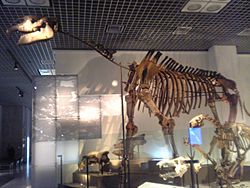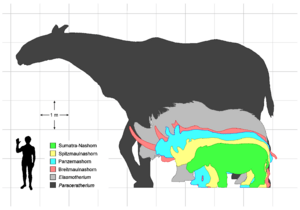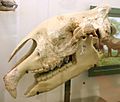Paraceratherium facts for kids
Quick facts for kids Paraceratherium |
|
|---|---|
 |
|
| Skeleton cast of P. transouralicum, National Museum of Nature and Science, Tokyo | |
| Scientific classification | |
| Kingdom: | |
| Class: | |
| Order: | |
| Family: |
†Hyracodontidae
|
| Subfamily: |
†Indricotheriinae
Borissiak, 1923
|
| Genus: |
Paraceratherium
Borissiak, 1915
|
Paraceratherium was an amazing extinct mammal. It was a giant rhinoceros that didn't have a horn! This huge animal lived in Eurasia about 34 to 23 million years ago, during a time called the late Oligocene epoch.
Paraceratherium is known as one of the largest land mammals ever! Its exact size is a bit of a mystery because we don't have all its fossils. But scientists think adults were about 4.8 meters (15.7 feet) tall and around 7.4 meters (24.3 feet) long. Imagine an animal as tall as a two-story building!
What Paraceratherium Was Like
This giant rhino was a herbivore, meaning it only ate plants. It loved to strip leaves from trees, just like a modern giraffe might. It had a long, flat head without a horn, and long bones in its face.
Its front teeth were quite special. It had one pair of incisor teeth in its upper jaw and one pair in its lower jaw. These teeth were round, pointed, and so big they looked like small tusks! The upper tusks pointed straight down, while the lower ones stuck out. Scientists believe its upper lip was very flexible, helping it grab leaves. Paraceratherium also had a very long neck, a big, strong body, and thick, column-like legs.
How Big Was Paraceratherium?
Figuring out the exact size of Paraceratherium is tricky. This is because the fossils we have are not complete. Scientists have estimated its size by looking at its skull, teeth, and leg bones. However, these bones come from different animals, so putting together a full skeleton is like solving a giant puzzle!
Because of this, estimates for its weight have changed a lot, from 11 to 20 tonnes. That's like the weight of several large trucks! Its maximum height at the shoulders was thought to be around 6 meters (19.7 feet). Its length from nose to tail was about 8 meters (26.2 feet). Remember, these numbers are just estimates for the largest of the Paraceratherium species.
Images for kids
-
Preparator Otto Falkenbach with a P. transouralicum skull at the American Museum of Natural History.
-
The upper molar teeth of P. transouralicum at the Musée d'Histoire Naturelle, Paris.
-
A map showing where Paraceratherium species were found during the early (yellow) and late (red) Oligocene period, according to Deng and his team in 2021.
See also
 In Spanish: Paraceratherium para niños
In Spanish: Paraceratherium para niños










